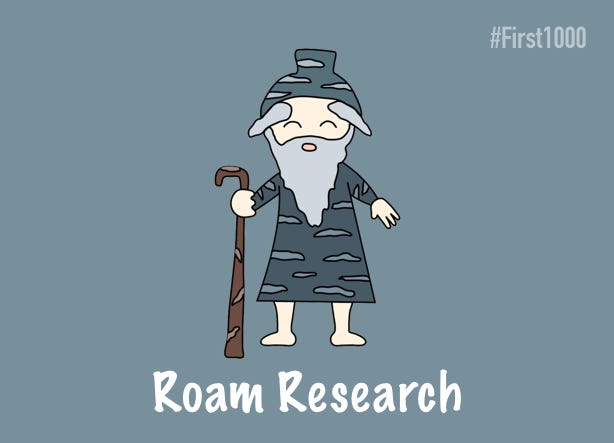📗Roam Research
How Roam Research got their first 1000 customers
Some background info
Roam is a note-taking tool for the "networked brain."
What does that mean?
It emulates how your brain works, which is in a mashed web of interconnected thoughts rather than a linear and folder structure.
How did it come to be?
Before founding Roam, Conor founded two prior businesses and also worked at HuffPost as a Co-Founder of HuffPost Labs, where he reported directly to Arianna Huffington and HuffPost CTO.
Ok, let's dive into the first 1000
The Tesla Go to market strategy 🚙
Tesla's started with the sports car, the high-end complex cumbersome version of what they were trying to do. They went after the people who loved cars and would appreciate the subtle and nuanced improvements they can bring to the industry, even if, at first, they came at the cost of complexity, price, and other variables. These were the loudest and most cynical people to please, but at the same time the most advocate and passionate users of cars in general.
The Roam Adoption of Tesla Go to Market 🚙
Similarly, when Roam Research started, their quest was to find those same kinds of users. Users with a problem that is so complex that they were willing to learn and adopt new tools and workflows.
These were not your "CEOs" or "Twitter influencers." These were..
AI safety community
People thinking about AI risk, who had to do a lot of research, understand and dissect a complicated topic.
Rationalist Bay Area thinkers
People who think about thinking. They were working on understanding how to process emotions and deal with thinking biases.
In fact, despite being a "hyped" consumer product, their first 1000 or so users came exclusively from enterprise license deals with a handful of these organizations. As long as they kept building features, those researchers and philosophers would continue using the product and Roam were able to charge and renew their enterprise license deals.
The misconception of "waiting lists."
A few years of developing the "sports car" features of Roam -in congestion with working very closely with power users to find product-market fit- came the "request access" feature that many wrongly attribute as the key driver to their “popularity.”
Nevertheless it is still an important aspect on how to scale demand once you MOVE BEYOND YOUR FIRST 1000 users. Let’s dive a bit into the phenomena of #RoamCult which is their current growth catalyst.
🧟♂️#RoamCult...the product side
From a product perspective, Conor describes his Roam as a "Low Floor High Ceiling" product. Which means they created a product with a very low entry point and a very steep learning curve. The learning curve is a crucial component behind much of the momentum of the product. Roam is very easy to get started and very powerful if you learn it(..similar to how excel) is, and the steep learning curve is good! Even though it is a lot of effort, that means users can learn it quickly and become that much more powerful and unlock the "superpowers" of your product. That is a primary ingredient of making people vocal about your product.
🧟♂️#RoamCult..the Twitter side
Conor used twitter like he did roam, creating threads and threads of threads of the philosophy behind the product. Roam and other popular products with cult following had in common a strong belief about how things "ought to be" rather than how they are. And this is how Conor leveraged twitter to create a strong following behind Roam.
It has seldom been the case that a founder uses his "social capital" to build hype behind a product but instead using his "product" to build hype around himself and consequently, his product.
Here are a few actionable examples on how he did that
Tweeting abt why Evernote is a terrible second brain
Tweeting about the frustration of using tools that force people to think in a "linear model."
Getting into fights with people who like Evernote and explain why they are fundamentally wrong.
Explaining the science, math, and psychology about how a human brain works.
It doesn't hurt be loud and opinionated abt what your beliefs. It will resonate with some, frustrate others, but that is the case with any fundamentally different product.. it challenges the current mode of thinking.
🧟♂️#RoamCult..the mission side
A cult has a shared belief and mission that resonates very strongly with a concentrated group of people. For Roam, that mission was and still is "building a second brain."
Building on from there
What we see now from the rising popularity of Roam Research is the result of building a product with the most cynical power users for a couple of years and having a crystal clear view on how note-taking ought to be and being loud about it.
But more specifically, here is how they got from enterprise deals to the hottest consumer product in 2020.
Going after people who are willing to learn how to use power tools. Instead of the lowest common denominator. People who may individually exhibit the same characteristics as researches. Those are your "intellectual athletes."
Intellectual athletes are your writers, researchers, and people who "hacked" twitter as a medium to express their thoughts and views of different topics and beliefs.
Intellectual athletes often have a following of people that aspire to think and act like them. They are the so called “thought leaders”
Intellectual athletes are prone to being power users, and Roam's efficacy in the connecting different thoughts makes them likely to personally drive next-wave customers.
In essence, instead of appealing to the public or the "most influential," Roam went after the people "most likely to be a power user." and those people did all the heavy lifting.

